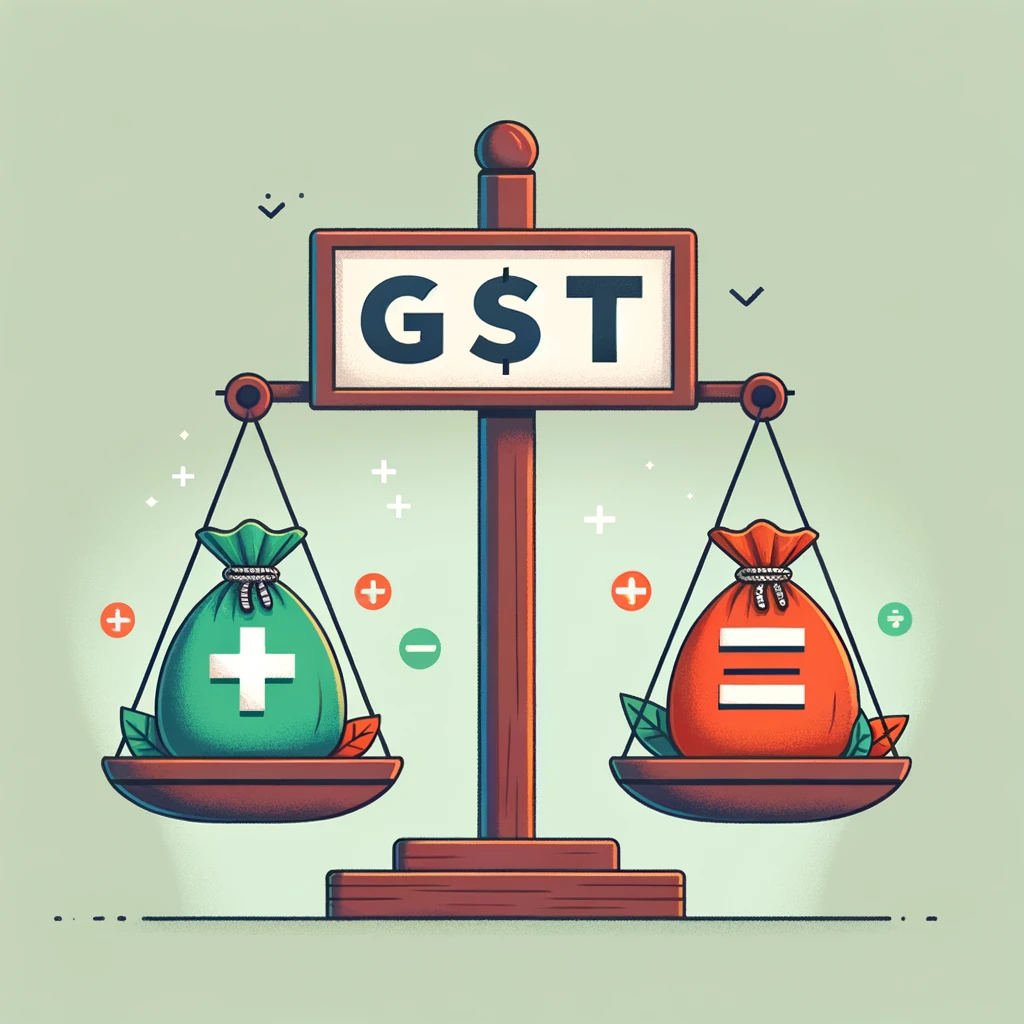Key Takeaways
- GST represents a unified indirect tax system that consolidates various central and state taxes into one, aiming to eliminate the cascading effect of taxes.
- The introduction of GST was a strategic move to simplify the tax regime, enhance compliance, boost the economy, and create a unified national market.
- GST is categorized into four types: CGST, SGST, IGST, and UTGST, each addressing different aspects of tax levies on goods and services.
- While GST has streamlined tax administration and reduced costs for consumers, it has also presented challenges, particularly for small businesses and the real estate sector.
- The GST framework, despite its advantages, involves complexities and ambiguities that necessitate ongoing refinement to support sustainable business growth.
What Is GST?
The Goods and Services Tax (GST) is a revolutionary tax reform that represents a single, unified indirect tax system in India. It encompasses various central and state taxes into one tax regime, levied on the manufacture, sale, and consumption of goods and services throughout the country. GST is a destination-based, multi-stage tax, applied at every point of sale, where the final consumer bears the tax. It is charged on the value added at each stage of the supply chain, allowing for the seamless flow of input tax credit, thereby reducing the overall cost of goods and services and eliminating the cascading effect of taxes.
GST is categorized into four types based on the nature of the transaction: Central Goods and Services Tax (CGST), State Goods and Services Tax (SGST), Integrated Goods and Services Tax (IGST), and Union Territory Goods and Services Tax (UTGST). CGST and SGST/UTGST are levied on intra-state transactions, shared between the central and state governments, while IGST is charged on inter-state transactions and imports, accruing to the central government but shared with the destination state.
Why Was GST Introduced in India?
GST was introduced in India to address and rectify a fragmented and complex indirect tax structure that was full of inefficiencies and the cascading effect of taxes. Prior to GST, the Indian tax system consisted of various taxes levied by the central and state governments, including but not limited to Value Added Tax (VAT), Service Tax, Excise Duty, and Central Sales Tax (CST). This system not only made tax compliance cumbersome for businesses but also led to the double taxation of goods and services, inflating costs for consumers and creating barriers to a unified national market.
The primary objectives behind the introduction of GST were:
- To Eliminate the Cascading Effect of Taxes: GST was designed to remove the tax-on-tax effect, ensuring that taxes paid on inputs could be availed as credit, thereby reducing the final cost to the consumer.
- To Simplify the Tax Structure: By consolidating multiple indirect taxes into a single tax, GST simplified the tax regime, making it easier for businesses to comply and for the government to administer.
- To Enhance Compliance and Broaden the Tax Base: A simpler tax system, coupled with technology-driven compliance mechanisms under GST, aimed to improve tax compliance rates and broaden the tax base.
- To Boost the Economy and Promote Growth: By reducing the cost of goods and services, GST aimed to stimulate consumer demand, promote economic growth, and enhance the competitiveness of Indian goods and services in the global market.
- To Create a Unified National Market: GST sought to break down fiscal barriers between states, facilitating the free flow of goods and services across the country, thereby creating a single, unified national market.
The introduction of GST on July 1, 2017, marked a significant milestone in India’s economic history, representing the culmination of years of effort towards tax reform aimed at fostering a more transparent, efficient, and growth-oriented tax environment.
Types of Tax Levied as GST

The Goods and Services Tax (GST) framework in India has significantly transformed the landscape of indirect taxation, streamlining tax burdens and simplifying compliance for business owners. This unified tax system, aimed at reducing the cascading effect of taxes on goods and services, encompasses four primary types of taxes. Each of these taxes plays a crucial role in the filing of GST returns, GST registration, and adherence to the Composition Scheme. Here’s an overview of each tax type within the GST regime:
Central Goods and Services Tax (CGST)
CGST is a core component of India’s GST system, representing the central element of indirect taxation on intra-state transactions. Business owners are required to pay CGST on all transactions occurring within a single state, alongside SGST or UTGST. This necessitates accurate GST registration and diligent filing of GST returns to ensure compliance. The revenue collected under CGST contributes to the central government’s finances, streamlining the tax structure and reducing tax burdens.
State Goods and Services Tax (SGST)
SGST stands as the state counterpart to CGST, levied on intra-state supplies of goods and services. It mandates business owners to manage their tax liabilities efficiently, incorporating SGST charges in their tax returns. The introduction of SGST has unified various state-level taxes under the GST umbrella, simplifying the indirect taxation system and easing the tax burdens on consumers and businesses alike. The revenue from SGST directly benefits the state governments, supporting local infrastructure and services.
Integrated Goods and Services Tax (IGST)
IGST is designed to address the complexities of inter-state transactions, ensuring that tax revenue is allocated to the state where goods or services are ultimately consumed. This model facilitates the seamless transfer of input tax credit across state lines, crucial for business owners engaged in nationwide operations. The filing of GST returns under the IGST model requires careful documentation of inter-state transactions, making GST registration and compliance a pivotal aspect of business operations. IGST effectively redistributes tax revenue among states, aligning with the destination principle of indirect taxation.
Union Territory Goods and Services Tax (UTGST)
UTGST applies specifically to transactions within Union Territories, functioning alongside CGST to tax goods and services. This ensures that Union Territories are integrated into the national GST framework, with business owners in these regions adhering to similar registration and filing protocols as their counterparts in states. UTGST simplifies the tax return process for businesses in Union Territories, reducing the indirect tax burden and facilitating a more uniform tax structure across the country.
The GST system, with its comprehensive approach to indirect taxation, has significantly eased the tax burdens on business owners, encouraging compliance through simplified tax returns, GST.
GST Advantages

The introduction of the Goods and Services Tax (GST) in India has brought about significant changes in the tax landscape, offering numerous advantages that span from simplifying the tax system to boosting the economy. Here’s a closer look at the key benefits GST has introduced:
Simplification of the Tax System
Prior to GST, the Indian tax system was mired in complexity, with a plethora of indirect taxes levied by both the central and state governments. GST has consolidated these multiple taxes into a single, unified tax regime, making it easier for businesses to understand their tax obligations. This simplification has significantly reduced the administrative burden on businesses, enabling them to focus more on their core activities rather than on navigating the complexities of the tax system.
Boost to the Economy
GST has been a catalyst for economic growth in India. By creating a single national market, it has eliminated the barriers to inter-state trade, such as entry taxes and check posts, thereby facilitating the smooth flow of goods and services across the country. This has not only increased the efficiency of logistics and distribution but also attracted foreign investment, as the tax system is now more transparent and business-friendly. The resultant increase in production and trade activities has contributed to the overall growth of the Indian economy.
Increase in Government Revenues
One of the primary objectives of GST was to broaden the tax base and increase government revenues, and it has been successful in achieving this goal. By simplifying the tax structure and making compliance easier, GST has encouraged more businesses to register and pay taxes, thereby increasing tax collections. Additionally, the system’s design to minimize tax evasion through input tax credit mechanisms has further boosted government revenues.
Enhanced Compliance and Transparency
GST has introduced a technology-driven compliance system that has made the tax administration process more efficient and transparent. The GST portal enables electronic filing of tax returns, payment of taxes, and application for refunds, making the process faster and more reliable. This digital approach has not only reduced the chances of human error but also curbed corruption and tax evasion, leading to enhanced compliance and transparency in the tax system.
Removal of the Cascading Effect of Taxes
Perhaps one of the most significant advantages of GST is the elimination of the cascading effect of taxes, or “tax on tax.” Under the previous tax regime, businesses were not able to claim input tax credits for all the taxes paid on inputs, leading to an increase in the cost of goods and services. GST allows businesses to claim input tax credit for the GST paid on inputs, reducing the cost of goods and services and making them cheaper for the end consumer. This has not only benefited consumers but also improved the competitiveness of Indian goods and services in the international market.
GST Disadvantages
Despite the numerous benefits brought about by the Goods and Services Tax (GST) in streamlining the indirect tax regime, it has also introduced several challenges and disadvantages, particularly affecting small indian businesses, the real estate sector, and compliance processes. Here are some of the key disadvantages associated with GST:

Compliance Costs for Small Businesses

Small businesses, especially those with limited annual turnover, have found themselves grappling with the increased compliance costs under GST. The need to adhere to the GST framework, including regular filings and digital record-keeping, has imposed financial and operational burdens on small enterprises that previously operated under simpler tax structures or were exempt from service tax and other indirect taxes.
Technological Challenges
The shift to a digital-first approach in tax filing and compliance under GST has posed technological challenges for many businesses. Those located in areas with limited access to reliable internet services or those lacking digital literacy have struggled to keep up with the requirements for online filings, digital invoices, and electronic payments, leading to disruptions in their operations.
Increased Operational Costs
The implementation of GST has led to increased operational costs for businesses across various sectors. This includes the costs associated with updating accounting software, training staff on GST compliance, and hiring tax consultants to navigate the complexities of the new tax regime. For businesses that engage in the supply of goods across state lines, understanding and managing the implications of IGST on interstate transactions has added to these operational challenges.
Impact on the Real Estate Sector
The real estate sector has experienced significant impacts due to GST, particularly in how it has affected project costs and, consequently, property prices. While GST has aimed to bring transparency and reduce tax evasion, the inclusion of real estate transactions under its purview has led to increased tax burdens on under-construction properties, affecting both developers and buyers.
Ambiguity and Complexity in Regulations
The GST framework, despite its intent to simplify the tax landscape, has introduced a level of ambiguity and complexity in regulations that businesses must navigate. This includes confusion over GST rates applicable to various goods and services, the classification of items under different tax slabs, and the interpretation of rules regarding input tax credits. Such ambiguities have made compliance more challenging and have led to uncertainties in tax planning and financial management for businesses.
In conclusion, while GST has unified the indirect tax regime and brought several advantages, it also presents a set of challenges that require attention and continuous refinement to ensure that the tax system supports the growth and sustainability of businesses across all sectors of the Indian economy.
💡You can use Pice Business Payment App to pay all your business expenses like GST, Vendor, Utilities and many more, with your credit card at the cheapest price.
FAQs
What is GST and how does it work in detail?
The Goods and Services Tax (GST) is a landmark reform in India’s taxation system, introducing a unified framework to subsume a variety of previously existing taxes such as VAT, Service Tax, Excise Duty, etc. It’s a multi-stage tax applied to each stage of the supply chain, ensuring that goods and services are taxed only on the value added at each stage, with the ultimate burden falling on the end consumer. This destination-based approach aims to streamline the flow of input tax credits, thereby reducing the overall tax burden and eliminating the inefficiencies of the former tax structure. The implementation of GST has necessitated significant changes in how businesses operate, including the need for digital compliance and regular updates to accounting practices.
Why was GST introduced in India, and what objectives does it aim to achieve?
GST was introduced as a solution to the fragmented and cumbersome indirect tax regime that existed in India, characterized by a plethora of state and central taxes that often overlapped and led to double taxation. The primary objectives behind the introduction of GST were to dismantle the cascading effect of taxes, thereby making goods and services cheaper for consumers, simplifying the tax structure for businesses to enhance compliance, broadening the tax base, and increasing government revenues. Additionally, GST aims to boost the Indian economy by creating a single, unified national market that facilitates the free and efficient flow of goods and services across state borders.
Can you explain the different types of GST in India?
India’s GST system is divided into four main categories to address the dual nature of its federal structure, allowing both the central and state governments to collect taxes simultaneously. Central Goods and Services Tax (CGST) and State Goods and Services Tax (SGST) or Union Territory Goods and Services Tax (UTGST) are levied on all intra-state transactions, with revenues being shared between the central and respective state or union territory governments. Integrated Goods and Services Tax (IGST) is charged on all inter-state transactions as well as imports, with the revenue collected by the central government then distributed to the destination state. This structure ensures that taxes are collected based on the destination principle, aligning with GST’s aim to be a consumption-based tax.
How has GST impacted small businesses in India in more detail?
For small businesses, GST has been a double-edged sword. On one hand, it has simplified tax compliance by replacing multiple taxes and reducing the likelihood of tax evasion. The Composition Scheme, for instance, allows small businesses with an annual turnover below a certain threshold to pay GST at a fixed rate of their turnover, simplifying their tax processes. On the other hand, the transition to GST has posed challenges, including the need for digital compliance, increased administrative work for monthly and quarterly tax filings, and the initial cost of adapting to the new system. These challenges have necessitated that small businesses invest in technology and seek professional assistance, increasing their operational costs.
What technological challenges have arisen due to GST implementation, and how do they affect businesses?
The digital-first approach of GST, requiring businesses to file returns and manage tax payments online through the GST portal, has introduced significant technological challenges. Businesses, especially small and medium-sized enterprises (SMEs) in rural or semi-urban areas with limited access to reliable internet and digital infrastructure, have found it difficult to comply with these requirements. The need for digital literacy, upgrading IT systems, and the ongoing maintenance of digital records have increased the operational complexity and costs for businesses, requiring them to invest in training and technology.
How does GST affect the real estate sector in more depth?
The impact of GST on the real estate sector has been nuanced. On one hand, it has simplified the tax structure by subsuming various previous taxes into a single tax, potentially reducing the overall tax burden on new property purchases. However, the application of GST on under-construction properties has increased the tax burden on buyers, as the cost of construction materials and input services are subject to GST. While the input tax credit is available, the actual benefit to the end consumer depends on the transparency and pricing strategy of the developers. Moreover, the sector has seen increased transparency and a reduction in tax evasion, contributing to a more organized real estate market.
What are the comprehensive advantages and disadvantages of GST?
The advantages of GST are significant, including the simplification of the tax system, elimination of the cascading effect of taxes, enhancement of compliance and transparency, and the creation of a unified national market that supports the free flow of goods and services. These benefits contribute to a more efficient and competitive economy. However, the disadvantages cannot be overlooked; small businesses face increased compliance costs and the need to adapt to digital processes, there are technological challenges associated with online tax filing, operational costs have risen due to the need for system upgrades and professional services, and there is ongoing ambiguity and complexity in GST regulations that require clarification. Balancing these advantages and disadvantages is crucial for the continued success and acceptance of GST in India.








